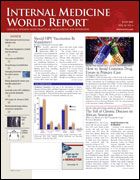Publication
Article
Internal Medicine World Report
Virtual Colonoscopy Most Cost-Effective for Colon Cancer Screening
Author(s):
But Questions about Polyps <6 mm Remain
Cancer
Targeting lesions <5 mm found by colonoscopy increases costs and the risk of adverse events without significantly reducing the incidence of colorectal cancer, investigators report in (2007;109:2213-2221).
The low rate of malignancy in these "diminutive" polyps makes computed tomography colonography (CTC), also known as virtual colonoscopy, with follow-up removal of lesions ≥6 mm the most cost-effective, and least complicated, diagnostic technique.
IMWR
"Tiny or diminutive polyps of 5 mm or less are not clinically relevant and lead to unnecessary procedures and complications if not ignored," lead investigator Perry Pickhardt, MD, associate professor of radiology at the University of Wisconsin Medical School in Madison, told . "This study demonstrates that CTC is not only a clinically effective screening tool but is highly cost-effective as well. In fact, CTC appears to be the most cost-effective and safest test for screening compared with endoscopic techniques."
Virtual colonoscopy (left) versus optical
endoscopy view of the same polyp.
Courtesy of Viatronix.
Unlike the standard methods of optical colonoscopy and flexible sigmoidoscopy, virtual colonoscopy uses x-rays and computer software to create 2- and 3-dimensional images of the gastrointestinal tract. Since it is noninvasive, there is no risk of complications, such as bowel perforation or bleeding, which can occur with traditional endoscopic methods.
Previous studies have concluded that optical colonoscopy is more cost-effective than virtual colonoscopy. But in all these studies, the assumption was that polyps <5 mm detected by virtual colonoscopy would be referred for polypectomy at the time of a follow-up optical colonoscopy.
"However," the investigators write, "current consensus guidelines for CTC interpretation recommend 6 mm as the minimum size for polyp reporting, which also reflects actual clinical practice. This discrepancy between the existing cost-effectiveness modeling and clinical practice for CTC screening was the primary motivation for the study," which sought to determine the clinical and economic impact of using a 6-mm polyp size threshold for virtual colonoscopy screening.
Using a hypothetical model, the investigators evaluated the cost-effectiveness—with and without the 6-mm reporting threshold—of CTC, optical colonoscopy, and flexible sigmoidoscopy. The model was applied to a hypothetical group of 100,000 persons at average risk of colorectal cancer, beginning at age 50 and continuing until age 80.
Results showed the most cost-effective strategy was CTC, with follow-up optical colonoscopy of polyps >5 mm.
CTC with a 6-mm threshold for follow-up cost $4361 per life-year gained, while optical colonoscopy cost $9180 per life-year. With no polyp-size threshold, CTC cost $7138, and flexible sigmoidoscopy cost $7407 per life-year gained.
The incremental cost of excising and examining lesions <6 mm discovered in an initial virtual colonoscopy resulted in a cost of $118,400 per additional life-year gained and accounted for more than 50% of all optical colonoscopy procedures. More than 50% of complications associated with optical colonoscopy were attributed to follow-up work on diminutive polyps. In addition, targeting tiny lesions for follow-up reduced colorectal cancer incidence by only 1.3%.
IMWR
However, noting that this study was not the gold-standard prospective clinical trial, Michael Kochman, MD, professor of medicine at the University of Pennsylvania School of Medicine and codirector of gastrointestinal oncology at the Hospital of the University of Pennsylvania, both in Philadelphia, told : "The most important clinical implication of this study is for the clinician to recognize that we do not have prospective, clinically verified data that support the conclusion that it is safe to ignore polyps less than 6 mm in size as defined by CTC. There is a paucity of prospective clinical data available to allow the clinician to feel comfortable with leaving these polyps in place."
Citing a growing body of literature concerning flat adenomas and serrated polyps, both of which are poorly detected by virtual colonoscopy, Dr Kochman added, "Safe is not simply defined as the lowest procedural risk but also should include the greatest overall benefit to the patient. Given that all are cost-effective, one would logically pick the test that provides the most years of life saved—colonoscopy."
The investigators argue that since colorectal cancer "remains the second- leading cause of cancer-related deaths in the United States, despite the fact that it is largely preventable through effective screening...the best screening test for a given individual may well be the test that they are willing to take."





